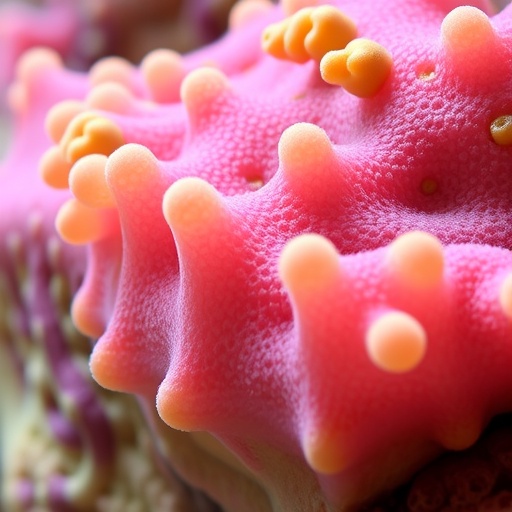In a groundbreaking discovery, researchers have isolated a novel antibiotic compound known as Emericellopsic acid, designated as compound 1, from a unique source: the sponge-associated fungus Emericellopsis maritima, specifically strain IMB18-123. This remarkable finding highlights the potential of exploring marine microorganisms for novel bioactive compounds, particularly in the context of rising antimicrobial resistance observed in various pathogens. Emericellopsic acid is being hailed as the first B/C ring-rearranged fusidane-type antibiotic, featuring an unusual and complex 6/5/7/5 fused ring framework that distinguishes it from other known antibiotics.
Emericellopsic acid was isolated through a meticulous cultivation process involving the co-culture with autoclaved Pseudomonas aeruginosa. Notably, this method of cultivation serves a dual purpose: enhancing the antibiotic-producing capacity of the fungal strain and shedding light on the intricate relationships between marine organisms and their associated microorganisms. The study sheds light on the successful extraction and identification of this unique compound, opening new avenues in the search for novel agents capable of combatting resistant bacterial strains.
The structural elucidation of Emericellopsic acid was achieved through a comprehensive analysis of spectroscopic data alongside electronic circular dichroism (ECD) calculations. This combination of techniques is pivotal in confirming the stereochemistry and overall structure of the compound, ensuring the accuracy of the results. Spectroscopic methods, such as nuclear magnetic resonance (NMR) and mass spectrometry (MS), alongside advanced computational techniques, allow researchers to precisely define the molecular architecture of this promising antibiotic.
In terms of efficacy, Emericellopsic acid demonstrated moderate antimicrobial activities against two notable strains of bacteria, Staphylococcus aureus and Staphylococcus epidermidis, exhibiting minimum inhibitory concentrations (MICs) ranging from 4 to 8 μg/ml. The significance of this finding cannot be overstated, especially in a time when antibiotic resistance presents a formidable challenge in treating bacterial infections. The moderate activity of Emericellopsic acid positions it as a potential candidate for further development and optimization in the pharmaceuticals industry.
The importance of natural products as a source for new antibiotics is underscored by this discovery. Historically, many of our existing antibiotics have been derived from natural compounds, showcasing the diverse biochemical capabilities of various organisms. The marine environment, in particular, has proven to be a rich and largely untapped source of bioactive molecules. The isolation of Emericellopsic acid emphasizes the need for continued exploration of marine biodiversity to uncover compounds that could lead to innovative therapeutic agents.
Furthermore, the relationship between marine organisms, such as the fungus Emericellopsis maritima, and bacterial species like Pseudomonas aeruginosa presents an interesting dynamic. The ability of the fungus to produce potent compounds may be attributed to the evolutionary pressures exerted by these associated bacteria, driving the need for effective defense mechanisms. This interaction highlights the concept of chemical ecology, where organisms produce bioactive compounds in response to their environment.
Emericellopsic acid represents not only a new chemical entity but also an insight into the ecological interactions at play within marine ecosystems. Understanding these dynamics can aid in the identification of similar organisms that could yield further therapeutic candidates. As the pharmaceutical landscape grapples with the limitations of current antibiotics, the importance of these discoveries becomes increasingly pertinent.
Future research will likely focus on the optimization of Emericellopsic acid’s synthetic routes and its potential modifications to enhance its antibacterial properties. Investigating the biosynthetic pathways responsible for its production could further unlock the potential for harnessing this compound and its derivatives as effective antibiotics. Moreover, the collaborative efforts of mycologists, chemists, and pharmacologists will be essential in translating these findings into clinically relevant treatments.
In summary, the discovery of Emericellopsic acid from the sponge-associated fungus Emericellopsis maritima marks a significant advancement in the field of antibiotic research. This compound’s unique structural attributes and its promising antimicrobial activity provide a glimmer of hope in the continuous fight against resistant bacterial strains. As research continues to unravel the complexities of marine organisms, the potential for discovering novel antibiotics remains vast and encourages a multidisciplinary approach to bioprospecting.
The intricate relationship between ecosystem health, biodiversity, and the discovery of new antibiotics cannot be overlooked. The isolation of Emericellopsic acid exemplifies how maintaining marine ecosystems is crucial not only for environmental sustainability but also for human health. As researchers delve deeper into marine mycology and its associated bacteriomes, the potential for finding transformative compounds becomes ever more apparent.
With the rise in resistant infections globally, the urgency for new antibiotic candidates such as Emericellopsic acid is critical. As the scientific community rallies towards innovative solutions, breakthroughs like this serve as a reminder of the valuable resources still waiting to be discovered in the natural world, reinforcing the idea that nature often holds the keys to solving complex human challenges.
In conclusion, Emericellopsic acid is a beacon of hope in antibiotic research, encouraging further investigation into the vast, unexplored territories of marine life for the next generation of therapeutics. Each step taken in understanding how these compounds interact with bacteria can lead to improved strategies in the battle against antimicrobial resistance. The journey of Emericellopsic acid is just beginning, and its potential impact on medicine may very well redefine our approach to treating infections in the future.
Subject of Research: Emericellopsic acid and its potential as an antibiotic.
Article Title: Emericellopsic acid, a helvolic acid derivative with a 6/5/7/5 tetracyclic skeleton from sponge-derived Emericellopsis maritima.
Article References:
Li, S., Hao, X., Li, Y. et al. Emericellopsic acid, a helvolic acid derivative with a 6/5/7/5 tetracyclic skeleton from sponge-derived Emericellopsis maritima.
J Antibiot 78, 580–585 (2025). https://doi.org/10.1038/s41429-025-00852-5
Image Credits: AI Generated
DOI:
Keywords: Antibiotic discovery, Emericellopsic acid, marine mycology, antimicrobial resistance, sponge-associated fungi.




